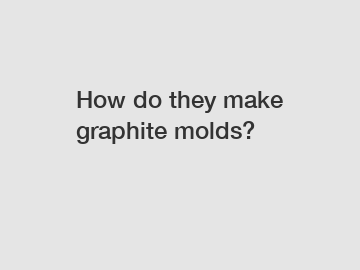How do they make graphite molds?
How do they make graphite molds?
Graphite molds are widely used in various industries, including automotive, aerospace, and jewelry, for their exceptional heat tolerance, electrical conductivity, and durability. These molds play a crucial role in manufacturing processes, enabling the production of complex and intricate objects. But have you ever wondered how they are made? In this article, we will explore the processes involved in creating graphite molds and delve into the reasons behind their popularity.
1. What is graphite and why is it favored for mold-making?

Graphite is a form of carbon that occurs naturally or can be produced synthetically. Its unique properties make it an ideal choice for graphite mold production. Firstly, graphite possesses high thermal conductivity, allowing it to withstand extreme temperatures without deforming or cracking. This characteristic is essential when dealing with molten metals or other materials that require high-temperature manufacturing processes. Additionally, graphite exhibits excellent electrical conductivity, ensuring efficient heat distribution throughout the mold. Lastly, graphite is an incredibly robust material, providing durability and long-lasting performance.
2. The process of creating graphite molds.
a. Design and mold requirements: The first step in creating graphite molds is determining the mold's design and specifications. This involves understanding the object to be cast and its intricacies. The mold designer incorporates this information to create a precise blueprint of the mold.
b. Material selection: Once the design is finalized, the appropriate graphite material is chosen. There are various types of graphite with different characteristics, such as fine-grain or high-density options. The selection depends on factors like the object's intricacy, desired surface finish, and expected lifespan of the mold.
c. Mold fabrication: The fabrication process begins with machining the graphite block into the desired mold shape. This is typically done using computer numerical control (CNC) milling, which ensures incredible precision and accuracy. The process involves removing the excess graphite material while adhering to the design specifications.
d. Surface treatment: After the initial milling process, the mold's surface is refined and smoothened for optimal functionality. This is achieved through techniques like polishing, sanding, or using specialized coatings. Surface treatment enhances the mold's release properties, improving the casting process and reducing the need for additional release agents or lubricants.
e. Final touches: Once the mold has been machined and treated, any remaining imperfections or rough edges are meticulously eliminated. This step ensures that the mold is flawless and ready for use.
3. Advantages of using graphite molds.
a. High heat resistance: One of the primary reasons for using graphite molds is their ability to withstand extreme temperatures. Graphite can sustain temperatures up to 3000°C, making it suitable for various casting applications, including metal casting and glass forming.
b. Excellent dimensional accuracy: Graphite molds can reproduce intricate and complex features with exceptional precision. This accuracy is crucial in industries such as jewelry-making, where intricate designs are frequently cast.
c. Enhanced surface finish: The smooth surface of graphite molds results in high-quality finishes for the cast objects. This saves time and effort in post-processing, as the mold itself contributes to achieving a desirable surface without the need for extensive polishing or refinements.
d. Reduced cycle time: Graphite molds provide efficient heat transfer, allowing for faster solidification of the cast material. With faster cycle times, manufacturers can increase production rates and improve overall productivity.
In conclusion, graphite molds are an integral part of various manufacturing industries, offering exceptional heat resistance, dimensional accuracy, and surface finish. The process of creating these molds involves meticulous design, material selection, fabrication, and surface treatment. With its unique properties and advantages, graphite continues to be the material of choice for mold-making. So, the next time you come across a precisely cast object, you'll have a deeper appreciation for the intricate process behind it. How do they make graphite molds? With precision, expertise, and graphite's remarkable qualities.
Contact us to discuss your requirements of graphite blocks for casting, high pressure crucibles, carbon artificial graphite block Supplier. Our experienced sales team can help you identify the options that best suit your needs.
266
0
0


Comments
All Comments (0)